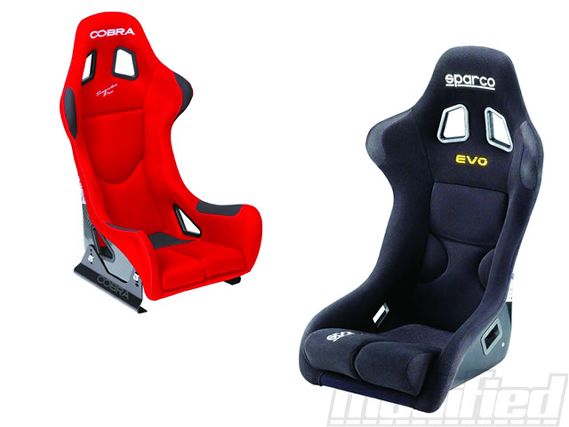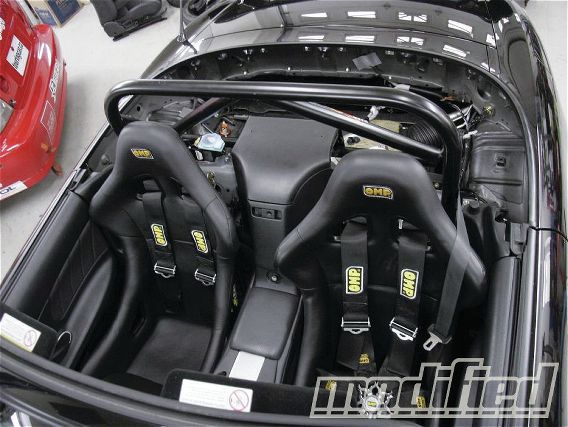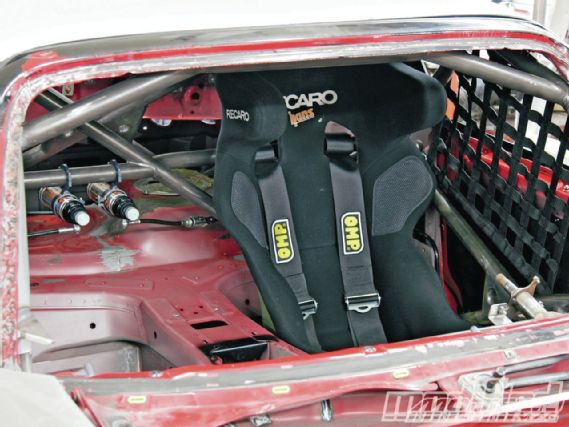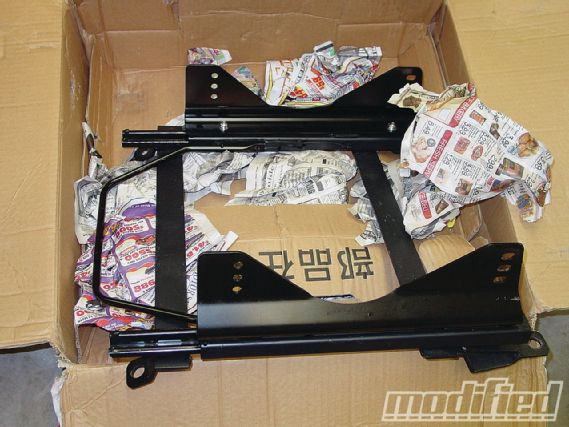 Bucket List - Tech Talk
Bucket List - Tech Talk
Send your feedback to dpratte@modified.com
If you’re a weekend warrior who enjoys some cone-dodging, time-attacking, grassroots drifting or just some good old-fashion hooning on a twisty piece of backcountry asphalt, then you’ve probably ended up with sore or even bruised legs from bracing yourself against the door and center tunnel. Simply put, the OE seat and 3-point seat belt in most street cars don’t offer anywhere near enough lateral support when cornering hard, which means you end up having to expend a lot of energy bracing yourself to minimize how much sliding around in the seat you’re doing.
 |
Bucket List - Tech Talk
|
Bucket List - Tech Talk
For those of you who’ve done some driving in a proper racing bucket with a 5- or 6-point harness holding you down snuggly, you’ll know how much easier it is to drive at the limit. No more bracing yourself against the door and center tunnel, and gone is that death grip on the steering wheel. Instead, you can focus on the road and all the subtle feedback your car is giving you through the seat of your pants and from a more lightly gripped steering wheel.
On the other hand, if you’ve ever spent some time in a racing bucket that fits you poorly, then you’ll know just how uncomfortable this can make the driving experience, especially during any sort of extended street use. So although budget and seat design/construction are very important considerations (more on these later), the single most important factor when choosing a racing bucket for your car is how well it fits your unique (and no doubt Weider-approved) physical dimensions.
SFI-certified seats cost a little extra since the certification process adds cost for the manufacturers, but you can’t put a price on crashworthiness and the safety of th
Well, OK, maybe seat fitment comes second to safety, so make sure the seats on your shopping list are SFI/FIA-certified (look for the SFI/FIA sticker on the shell of the seat), since anything that’s not certified hasn’t been crash tested during its R&D phase. There’s a reason just about every motorsports sanctioning body out there requires racers to equip their cars with SFI-certified seats and harnesses (as well as other safety items), and that reason is driver safety and the structural integrity of the seat during a serious crash. SFI-certified seats cost a little extra since the certification process adds cost for the manufacturers, but you can’t put a price on crashworthiness and the safety of the driver (that’s you, dummy).
 |
Bucket List - Tech Talk
|
Bucket List - Tech Talk
Now it’s time to find a seat that fits you properly. Racing buckets come in all shapes and sizes, and the way they’ve been padded and covered also varies a lot, too. Although you can begin your fitment research by looking at seat dimension charts online, just like buying a pair of jeans or shoes, there’s no substitute for trying them on before spending your money. Unless you happen to be attending a big trade show like SEMA or PRI where you can sit in just about every racing bucket on the planet in one day, your only option is to visit a variety of race shops to sit in different brand seats and try out the various models available.
If you have what’s sometimes referred to as “American proportions” (meaning a 36-plus-inch waist and the manboobs that go with it), then you can immediately narrow your search to seats offered in “big boy” sizes. For example, the popular Sparco Evo seat is offered in a number of larger sizes called the Evo 2, Evo 2 Plus and the Evo 3, while Recaro designates their full-figured buckets with the addition of a XL to the end of the seat’s name. Cobra, another highly reputable manufacturer of SFI/FIA-certified seats, adds a GT to the end of the name of their plus-size seats, while Bride uses the oh-so-JDM designation of Type-L.
Another important consideration when shopping for a racing bucket is seat construction. At the more affordable end of the SFI-certified spectrum are buckets made from FRP (fiber-reinforced plastic or polymer). The downside to FRP seats is that they’re heavier than their carbon fiber and/or aramid counterparts; the FRP version of Sparco’s Evo seat retails for $759, while the carbon-fiber version is more than twice the price at $1,899 but is also 6.4 lbs lighter (12.9 lbs versus 19.0 lbs for the FRP version). The weight savings comes from the fact that carbon fiber is significantly stronger than a typical FRP composite, meaning you can use quite a bit less of it when manufacturing a racing bucket while still achieving SFI/FIA approval. Kevlar or aramid is another popular material used in the construction of composite racing seats, Cobra particularly uses this high tensile-strength-to-weight-ratio material in FIA seats (which also tend to be about 30 percent lighter than FRP equivalents).
 |
As you can see, these OMP Grip buckets are a very tight fit in Project S2000, so make sure the seat you’re considering fits your car as well as your backside. We also mounted a Recaro Pro Racer HANS seat in our S2000, a seat that has the added benefit of head restraints.
|
As you can see, these OMP Grip buckets are a very tight fit in Project S2000, so make sure the seat you’re considering fits your car as well as your backside. We also mounted a Recaro Pro Racer HANS seat in our S2000, a seat that has the added benefit of head restraints.
There are also SFI/FIA-approved seats with a frame made from tubular steel, a couple popular examples being the Sparco Sprint and the Corbeau Forza. These seats are considerably less expensive than a FRP bucket from the same manufacturer, but with a weight and comfort penalty as a trade-off. The Corbeau Forza retails for $229 and weighs in at 26.5 lbs, while Corbeau’s FRP constructed yet still extremely affordable FX1 sells for $320 and tips the scales at 20 lbs.
What the prices and weights don’t tell you is how a tubular steel-framed seat fits compared to a composite seat. The tubular steel-framed seats tend to lack mid-back support and generally don’t distribute your weight evenly across the surface of the seat back and bottom, nor do the side bolsters offer the same degree of cushioning and support as a FRP seat from a reputable manufacturer. Where a FRP or carbon-fiber/Kevlar bucket has some flexibility to its shell, tubular steel frames are very rigid and therefore less able to move with you. As a result, you give up a significant amount of comfort in exchange for cost savings, and it’s also worth noting that since tubular steel-framed seats are entry level, the materials used for the seat cover tend to be cheaper and less durable over time.
Kevlar or aramid is another popular material used in the construction of composite racing seats.
A final but very important consideration when shopping for a racing bucket is how it mounts to the chassis and if it’ll fit properly in your car. If you own something with a tight interior — Honda’s S2000 and Mazda’s MX-5, for example — then you’ll want to do some research on what seats fit properly (without any interference with the door, B-pillar area or center tunnel). This may narrow your search considerably right off the bat, so make sure to consider the space constraints of your car before buying a seat.
 |
Make seat mounts part of your seat shopping homework, because a safely mounted seat that puts you in the right driving position is just as important as the seat itself.
|
Make seat mounts part of your seat shopping homework, because a safely mounted seat that puts you in the right driving position is just as important as the seat itself.
Some seats will give you the option of using either side mounts or bottom mounts, though most fixed-back racing buckets use side mounts only. Still, it’s worth looking at the mounting system when considering how easy (or difficult) it’ll be when it comes time to install your new seat. Some seat rails tend to position the seat much higher than others and you can also get “super low” seat rails from companies like Bride and Buddy Club, so also be sure to take into consideration head space and at what height you’d like to be positioned behind the wheel.
Oftentimes some customization of the seat rails will be needed to position the seat exactly the way you want it, or you may even have to get a completely custom set of rails built by a local race fab shop. But all this homework is well worth it in the end, since the experience of flogging your car like a rented mule will be greatly enhanced when you’re securely and snuggly attached to it via a supportive and well-fitted racing bucket (along with a racing harness, but that’s a topic for another month).
